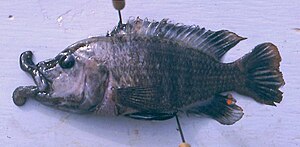Abactochromis labrosus
| Abactochromis labrosus | ||||||||||||
|---|---|---|---|---|---|---|---|---|---|---|---|---|

Abactochromis labrosus , adult male (11.5 cm standard length ). The soft, fleshy lips of the living animal lie on the head. They have been pulled forward here to show their length. |
||||||||||||
| Systematics | ||||||||||||
|
||||||||||||
| Scientific name of the genus | ||||||||||||
| Abactochromis | ||||||||||||
| Oliver & Arnegard , 2010 | ||||||||||||
| Scientific name of the species | ||||||||||||
| Abactochromis labrosus | ||||||||||||
| ( Trewavas , 1935) |
Abactochromis labrosus is an endemic species of cichlid from the East African Lake Malawi . It lives there on rocky coasts from the water surface to depths of 30 meters and is rare. The species epithet labrosus refers to the thickened lips of the species which, together with Cheilochromis euchilus ,occupiesthe ecological niche in Lake Malawiof Lobochilotes labiatus from Lake Tanganyika , Haplochromis chilotes from Lake Victoria and Amphilophus labiatus from Lake Nicaragua and Managua .
features
Abactochromis labrosus becomes twelve centimeters long and has a strongly flattened body on the sides. The fish is dark brown to almost black in color. There is also an orange-brown morph . There are 2 to 4 yellow egg spots on the anal fin of the males. Younger fish below 8 to 9 cm in length are light gray with 8 to 9 dark gray vertical stripes on the sides. The greatly enlarged, very sensitive lips are noticeable. They are often lighter in color than the rest of the body. In contrast to the lips of all other thick-lipped Malawi cichlids, the lips of Abactochromis labrosus are divided into a right and a left lobe by a central furrow. The number of vertebrae is 28 to 29 and is therefore smaller than in all other thick-lipped Malawi cichlids. The large head makes up 40% of the standard length for specimens that are larger than 5 cm . The sideline is broken. It runs from the front to the center of the body in the upper half of the body parallel to the back line, in the last third of the body two rows of scales lower along the body center line. The number of gill rakes is 13; they are unbranched.
Way of life
Abactochromis labrosus lives in rocky biotopes and with its narrow body is adapted to look for food in narrow cracks in the rock. The fish are solitary and aggressive towards other species. Like almost all cichlids in Lake Malawi, they are ovophilic mouthbrooders . The female carries the eggs around in her mouth for about 24 days until the young hatch. The number of eggs is 20 to 45. After the first free swimming, the fry do not come back into the mother's mouth.
Systematics
Abactochromis labrosus was first assigned to the genus Melanochromis by the British ichthyologist Ethelwynn Trewavas . However, since the species lacks the typical striations of the genus and it cannot be assigned to any other genus of Malawi cichlids, it was placed in the new monotypical genus Abactochromis in 2010 .
etymology
The generic name comes from Latin and is made up of "abactus" and "chromis". "Abactus" means driven, driven away and refers to the solitary (apparently non- territorial ) way of life of the fish and to the separation from the genus Melanochromis . Chromis is a genus of damselfish in which cichlids were previously placed. The specific epithet labrosus is derived from “labium”, Latin for lip. In the native Tonga language , the fish is called Nyamlepetu.
Synonyms
- Melanochromis labrosus Trewavas, 1935
- Haplochromis labrosus Loiselle, 1978; Merritt, 1978; Adler, 1979
- Cyrtocara labrosa Mayland, 1982
literature
- Oliver, MK, and ME Arnegard. 2010. A new genus for Melanochromis labrosus, a problematic Lake Malawi cichlid with hypertrophied lips (Teleostei: Cichlidae). Ichthyological Exploration of Freshwaters 21 (3): 209-232. PDF